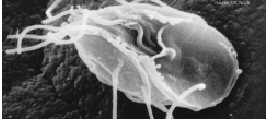|
Sappinia Diploidea
''Sappinia diploidea'' is a free-living amoeba species. Background ''Sappinia'' can be found worldwide. It usually occurs in elk and buffalo feces, places where farm animals are known to eat, soil containing rotting plants, and fresh water sources. Clinical significance It is capable of causing infectious disease in humans. Symptoms of Sappinia Infection Symptoms of a Sappinia infection include headache Headache is the symptom of pain in the face, head, or neck. It can occur as a migraine, tension-type headache, or cluster headache. There is an increased risk of depression in those with severe headaches. Headaches can occur as a result ..., photophobia, nausea or upset stomach, vomiting, blurred vision, and loss of consciousness. A scan of the one, infected patient’s brain also revealed a 2-centimeter tumor-like mass on the back left section of his brain. Treatment Treatment for the one identified case of Sappinia infection included the removal of a tum ... [...More Info...] [...Related Items...] OR: [Wikipedia] [Google] [Baidu] |
Eukaryota
Eukaryotes () are organisms whose cells have a nucleus. All animals, plants, fungi, and many unicellular organisms, are Eukaryotes. They belong to the group of organisms Eukaryota or Eukarya, which is one of the three domains of life. Bacteria and Archaea (both prokaryotes) make up the other two domains. The eukaryotes are usually now regarded as having emerged in the Archaea or as a sister of the Asgard archaea. This implies that there are only two domains of life, Bacteria and Archaea, with eukaryotes incorporated among archaea. Eukaryotes represent a small minority of the number of organisms, but, due to their generally much larger size, their collective global biomass is estimated to be about equal to that of prokaryotes. Eukaryotes emerged approximately 2.3–1.8 billion years ago, during the Proterozoic eon, likely as Flagellated cell, flagellated phagotrophs. Their name comes from the Greek language, Greek wikt:εὖ, εὖ (''eu'', "well" or "good") and wikt:� ... [...More Info...] [...Related Items...] OR: [Wikipedia] [Google] [Baidu] |
Amoebozoa
Amoebozoa is a major taxonomic group containing about 2,400 described species of amoeboid protists, often possessing blunt, fingerlike, lobose pseudopods and tubular mitochondrial cristae. In traditional and currently no longer supported classification schemes, Amoebozoa is ranked as a phylum within either the kingdom Protista or the kingdom Protozoa. In the classification favored by the International Society of Protistologists, it is retained as an unranked " supergroup" within Eukaryota. Molecular genetic analysis supports Amoebozoa as a monophyletic clade. Modern studies of eukaryotic phylogenetic trees identify it as the sister group to Opisthokonta, another major clade which contains both fungi and animals as well as several other clades comprising some 300 species of unicellular eukaryotes. Amoebozoa and Opisthokonta are sometimes grouped together in a high-level taxon, variously named Unikonta, Amorphea or Opimoda. Amoebozoa includes many of the best-known a ... [...More Info...] [...Related Items...] OR: [Wikipedia] [Google] [Baidu] |
Discosea
Discosea is a class of Amoebozoa, consisting of naked amoebae with a flattened, discoid body shape. Members of the group do not produce tubular or subcylindrical pseudopodia, like amoebae of the class Tubulinea. When a discosean is in motion, a transparent layer called ''hyaloplasm'' forms at the leading edge of the cell (see lamelliopodium). In some discoseans, short "subpseudopodia" may be extended from this hyaloplasm, but the granular contents of the cell do not flow into these, as in true pseudopodia. Discosean amoebae lack hard shells, but some, like '' Cochliopodium'' and '' Korotnevella'' secrete intricate organic scales which may cover the upper (dorsal) surface of the cell. No species have flagella or flagellated stages of life. The composition of Discosea is similar to that of the class Flabellinea, proposed by Alexey Smirnov and his collaborators in 2005. However, Discosea is a more comprehensive taxon, including several groups not included in Flabellinea. In 2011 ... [...More Info...] [...Related Items...] OR: [Wikipedia] [Google] [Baidu] |
Flabellinia
The Flabellinia are a subclass of Amoebozoa. During locomotion the cells are flattened and have a clear layer called ''hyaloplasm'' along the front margin. Some form slender subpseudopodia projecting outward from the hyaloplasm, but the cell mass does not flow into these as in true pseudopodia, and advances without a definite central axis as in the Tubulinea. They also lack distinctive features like shells and flagella A flagellum (; ) is a hairlike appendage that protrudes from certain plant and animal sperm cells, and from a wide range of microorganisms to provide motility. Many protists with flagella are termed as flagellates. A microorganism may have f ..., and are united mainly by evidence from molecular trees. The group was originally created by Alexey Smirnov and his coauthors as the class Flabellinea, which was similar in composition to the group Discosea, proposed by Cavalier-Smith ''et al.'' (2004). In 2011, Smirnov accepted Discosea as a class and reduced Fl ... [...More Info...] [...Related Items...] OR: [Wikipedia] [Google] [Baidu] |
Thecamoebidae
Thecamoebidae is an Amoebozoa Amoebozoa is a major taxonomic group containing about 2,400 described species of amoeboid protists, often possessing blunt, fingerlike, lobose pseudopods and tubular mitochondrial cristae. In traditional and currently no longer supported c ... family. '' Dermamoeba'' has been classified in this group. However, there is recent evidence that it is not closely related to the other members of this group. See also * '' Sappinia diploidea'' References Amoebozoa families Discosea {{Amoebozoa-stub ... [...More Info...] [...Related Items...] OR: [Wikipedia] [Google] [Baidu] |
Headache
Headache is the symptom of pain in the face, head, or neck. It can occur as a migraine, tension-type headache, or cluster headache. There is an increased risk of depression in those with severe headaches. Headaches can occur as a result of many conditions. There are a number of different classification systems for headaches. The most well-recognized is that of the International Headache Society, which classifies it into more than 150 types of primary and secondary headaches. Causes of headaches may include dehydration; fatigue; sleep deprivation; stress; the effects of medications (overuse) and recreational drugs, including withdrawal; viral infections; loud noises; head injury; rapid ingestion of a very cold food or beverage; and dental or sinus issues (such as sinusitis). Treatment of a headache depends on the underlying cause, but commonly involves pain medication (especially in case of migraine or cluster headache). A headache is one of the most commonly experi ... [...More Info...] [...Related Items...] OR: [Wikipedia] [Google] [Baidu] |
Photophobia
Photophobia is a medical symptom of abnormal intolerance to visual perception of light. As a medical symptom photophobia is not a morbid fear or phobia, but an experience of discomfort or pain to the eyes due to light exposure or by presence of actual physical sensitivity of the eyes, though the term is sometimes additionally applied to abnormal or irrational fear of light such as heliophobia. The term ''photophobia'' comes from the Greek φῶς (''phōs''), meaning "light", and φόβος (''phóbos''), meaning "fear". Causes Patients may develop photophobia as a result of several different medical conditions, related to the eye, the nervous system, genetic, or other causes. Photophobia may manifest itself in an increased response to light starting at any step in the visual system, such as: *Too much light entering the eye. Too much light can enter the eye if it is damaged, such as with corneal abrasion and retinal damage, or if its pupil(s) is unable to normally constrict (s ... [...More Info...] [...Related Items...] OR: [Wikipedia] [Google] [Baidu] |
Nausea
Nausea is a diffuse sensation of unease and discomfort, sometimes perceived as an urge to vomit. While not painful, it can be a debilitating symptom if prolonged and has been described as placing discomfort on the chest, abdomen, or back of the throat. Over 30 definitions of nausea were proposed in a 2011 book on the topic. Nausea is a non-specific symptom, which means that it has many possible causes. Some common causes of nausea are gastroenteritis and other gastrointestinal disorders, food poisoning, motion sickness, dizziness, migraine, fainting, low blood sugar, anxiety, and lack of sleep. Nausea is a side effect of many medications including chemotherapy, or morning sickness in early pregnancy. Nausea may also be caused by disgust and depression. Medications taken to prevent and treat nausea and vomiting are called antiemetics. The most commonly prescribed antiemetics in the US are promethazine, metoclopramide, and the newer ondansetron. The word nausea ... [...More Info...] [...Related Items...] OR: [Wikipedia] [Google] [Baidu] |
Vomiting
Vomiting (also known as emesis and throwing up) is the involuntary, forceful expulsion of the contents of one's stomach through the mouth and sometimes the nose. Vomiting can be the result of ailments like food poisoning, gastroenteritis, pregnancy, motion sickness, or hangover; or it can be an after effect of diseases such as brain tumors, elevated intracranial pressure, or overexposure to ionizing radiation. The feeling that one is about to vomit is called nausea; it often precedes, but does not always lead to vomiting. Impairment due to alcohol or anesthesia can cause inhalation of vomit, leading to suffocation. In severe cases, where dehydration develops, intravenous fluid may be required. Antiemetics are sometimes necessary to suppress nausea and vomiting. Self-induced vomiting can be a component of an eating disorder such as bulimia, and is itself now classified as an eating disorder on its own, purging disorder. Complications Aspiration Vomiting is dan ... [...More Info...] [...Related Items...] OR: [Wikipedia] [Google] [Baidu] |
Unconsciousness
Unconsciousness is a state in which a living individual exhibits a complete, or near-complete, inability to maintain an awareness of self and environment or to respond to any human or environmental stimulus. Unconsciousness may occur as the result of traumatic brain injury, brain hypoxia (inadequate oxygen, possibly due to a brain infarction or cardiac arrest), severe intoxication with drugs that depress the activity of the central nervous system (e.g., alcohol and other hypnotic or sedative drugs), severe fatigue, pain, anaesthesia, and other causes. Loss of consciousness should not be confused with the notion of the psychoanalytic unconscious, cognitive processes that take place outside awareness (e.g., implicit cognition), and with altered states of consciousness such as sleep, delirium, hypnosis, and other altered states in which the person responds to stimuli, including trance and psychedelic experiences. Law and medicine In jurisprudence, unconsciousnes ... [...More Info...] [...Related Items...] OR: [Wikipedia] [Google] [Baidu] |


